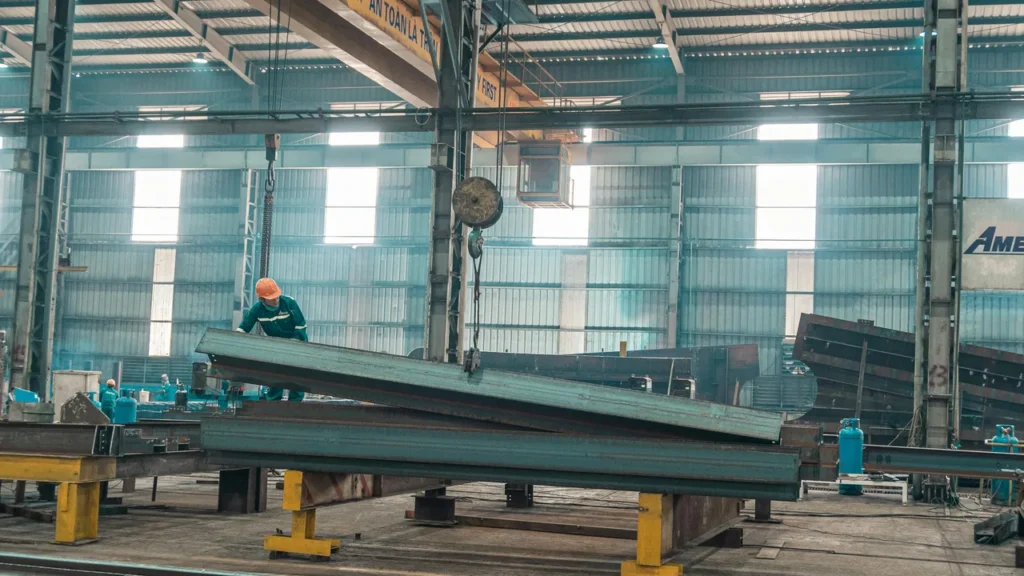In today’s manufacturing landscape, efficiency and precision determine success. Companies are no longer relying on outdated, rigid warehouse facilities. Instead, they are turning to steel structure warehouses—a modern, durable, and cost-effective solution that enhances logistics and operational performance. These structures are engineered to support seamless material flow, faster distribution, and optimized space utilization—all key factors in achieving competitive production cycles.
Manufacturers across different industries—from automotive to consumer goods—have recognized that a warehouse is more than just a storage facility. It is a central hub of production logistics, connecting raw materials, assembly lines, and delivery channels. By upgrading to a steel-based structure, companies can create flexible layouts that improve workflow efficiency and reduce downtime caused by poor spatial design.
Understanding Steel Structure Warehouses
A steel structure warehouse is a pre-engineered building system designed using structural steel components such as columns, beams, and trusses. The design allows for large, open spans without internal load-bearing walls, making it ideal for manufacturing and logistics operations that require wide floor areas and adaptable layouts. Unlike traditional concrete or brick warehouses, steel warehouses offer scalability and rapid assembly, significantly reducing project timelines.
Each component—roof purlins, wall panels, insulation systems, and foundations—is manufactured under precise quality control, ensuring consistency and structural integrity. The result is a building that can easily integrate with modern automation, storage systems, and energy-efficient utilities.
| Feature | Steel Structure Warehouse | Traditional Warehouse |
|---|---|---|
| Construction Time | 4–6 months (pre-engineered assembly) | 12–18 months (on-site construction) |
| Cost Efficiency | Lower due to prefabrication | Higher due to labor and material waste |
| Durability | High (corrosion-resistant steel) | Medium (subject to cracking and weathering) |
| Flexibility | Easy to expand or reconfigure | Limited flexibility after construction |
Enhancing Workflow Efficiency
One of the most significant advantages of using a steel structure warehouse is the improvement in workflow efficiency. The open-span design enables a smooth flow of materials and products throughout the facility, minimizing bottlenecks. Forklifts and automated guided vehicles (AGVs) can move freely without obstruction, while strategically positioned loading bays reduce turnaround time for shipments.
Additionally, modular layouts allow manufacturers to customize zones for specific production activities—such as raw material intake, processing, assembly, packaging, and dispatch—without structural limitations. This flexibility makes it easier to adopt lean manufacturing principles, where every second and every movement counts.
- Faster material movement — reduces idle time between production stages.
- Reduced handling time — minimizes manual transfers and improves worker safety.
- Improved visibility — enhances coordination and supervision within the warehouse.
Some manufacturers integrate overhead cranes and conveyor systems into their steel structure warehouse layouts to achieve continuous production flow. The result is a more synchronized system where goods are stored, transported, and dispatched with minimal delays.
Improving Inventory Management
Efficient inventory management is another core benefit of a steel-based warehouse. The structural design supports mezzanine levels, tall racking systems, and multi-tiered shelving that maximize vertical storage capacity. This vertical optimization reduces the need for additional land area, which is particularly valuable for manufacturers operating in space-constrained industrial zones.
Incorporating warehouse management systems (WMS) within a steel structure warehouse helps track materials in real-time, reducing errors and improving supply accuracy. The building’s internal geometry also allows easy installation of sensors, barcode scanners, and automated inventory control systems that work together to streamline operations.
Climate control and zoning within steel warehouses provide another edge. Certain production goods—especially chemicals, electronics, and perishables—require temperature or humidity regulation. The insulation-friendly design of a steel structure warehouse ensures consistent environmental conditions, helping preserve material quality and compliance with production standards.
For instance, a mid-sized electronics manufacturer redesigned its facility using a modular steel layout. By integrating automated racks and vertical lifts, the company improved storage density by 35% and reduced order-picking times by 25%. This example highlights how an engineered structure directly contributes to better inventory management and logistical accuracy.
Cost and Time Efficiency in Construction
Another decisive advantage lies in the construction process itself. Building a steel structure warehouse takes significantly less time than erecting a traditional concrete one. Since the components are pre-engineered and fabricated off-site, on-site assembly is faster, cleaner, and less labor-intensive. This quick turnaround allows businesses to begin operations sooner and realize returns on investment faster.
| Construction Type | Average Duration | Estimated Cost (per sqm) |
|---|---|---|
| Steel Structure Warehouse | 4–6 months | $250–$350 |
| Concrete Warehouse | 12–18 months | $400–$550 |
Steel’s low maintenance requirements also translate into long-term savings. Coated with anti-corrosion and fire-resistant layers, modern steel materials can last for decades with minimal upkeep. This combination of speed and sustainability makes it the most preferred choice for industrial and logistics developers worldwide.
Sustainability and Long-Term Performance
Modern industries are increasingly aligning their operations with sustainability goals. A steel structure warehouse supports this transition by offering an environmentally responsible alternative to conventional materials. Steel is 100% recyclable, and most structural components can be reused or repurposed when a building reaches the end of its lifecycle. This not only minimizes waste but also reduces the carbon footprint associated with manufacturing and construction.
Additionally, steel buildings are designed with energy efficiency in mind. Proper insulation, natural ventilation, and skylight installations reduce the need for artificial lighting and air conditioning. As a result, manufacturers benefit from lower operational costs and improved workplace comfort for employees. In many cases, energy savings alone can offset part of the initial construction investment within a few years.
Maintenance is another area where steel clearly outperforms traditional materials. The durability and corrosion resistance of modern steel alloys mean that even in humid or industrial environments, the structure remains stable for decades with minimal repair. The combination of sustainability, strength, and cost-effectiveness makes steel warehouses a long-term asset for production logistics.
Case Example — Transforming Production with a Steel Structure Warehouse
To understand the practical benefits of a steel structure warehouse, consider a real-world example from a medium-sized automotive parts manufacturer. The company was struggling with inefficient material flow and high storage costs in its old concrete warehouse. Transport routes between manufacturing and packaging areas were lengthy, and frequent bottlenecks delayed shipments to clients.
By partnering with a professional steel construction company, the manufacturer redesigned its entire logistics system. The new warehouse featured a 30-meter clear span, automated conveyor belts, and strategically positioned loading docks. Within the first six months, the facility reported measurable improvements:
- 30% faster dispatch time due to optimized internal routing.
- 25% increase in storage capacity thanks to vertical shelving systems.
- 15% reduction in operational costs through lower maintenance and energy consumption.
Furthermore, the flexibility of the steel framework allowed the company to easily install a mezzanine level for administrative offices and quality control labs. This integration streamlined decision-making and improved communication between warehouse staff and production supervisors. The success of this transition demonstrates how an engineered structure can be a direct driver of productivity and profitability.
Why Manufacturers Prefer Steel Structure Warehouses
Manufacturers worldwide are prioritizing resilience, speed, and scalability in their facilities—and that’s exactly what a steel structure warehouse delivers. The combination of fast assembly, adaptability, and long lifespan gives companies the flexibility to meet changing market demands. Whether scaling up for higher production volumes or reconfiguring layouts for new machinery, steel structures can easily accommodate growth without major reconstruction.
From an engineering perspective, these buildings also provide superior load-bearing capacity and resistance to extreme weather conditions. The frame can support heavy equipment such as cranes and mezzanines while maintaining minimal vibration levels, ensuring precision in sensitive production environments. This makes them particularly ideal for manufacturing sectors like automotive, energy, and heavy equipment fabrication.
Industry reports from logistics associations and engineering institutions confirm that steel-based construction has become the backbone of modern warehousing. With shorter build times, lower total cost of ownership, and unparalleled structural performance, manufacturers see it as the most reliable long-term investment in production logistics.
Partnering with Experts in Steel Structure Construction
Building an effective production warehouse requires more than just good materials—it demands expertise and precision. Working with an experienced contractor ensures that every aspect, from load design to ventilation, meets industry standards and operational requirements. Partnering with a specialist such as steel structure warehouse experts guarantees that your facility is built with world-class quality and long-term performance in mind.
Professional steel builders provide end-to-end solutions, including architectural design, structural analysis, material sourcing, and on-site installation. Their knowledge of regional codes, safety standards, and sustainability regulations helps ensure smooth project execution from start to finish. Whether it’s a manufacturing warehouse, distribution center, or logistics hub, a trusted partner can make all the difference in achieving your productivity goals.
Conclusion — Building for the Future of Manufacturing
As manufacturing continues to evolve, the need for adaptable and efficient logistics systems grows stronger. A steel structure warehouse provides the ideal foundation for modern production, offering unmatched flexibility, speed, and sustainability. By optimizing workflow efficiency and improving inventory management, these structures redefine how companies approach logistics.
From faster construction and lower costs to long-term durability and eco-friendly performance, steel remains the most future-ready choice for the manufacturing industry. Businesses that invest in well-engineered warehouses today position themselves for growth, competitiveness, and resilience in the decades to come.
External Reference
For more insights into modern inventory management strategies and their impact on production logistics, refer to global standards and studies published by logistics organizations.



